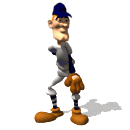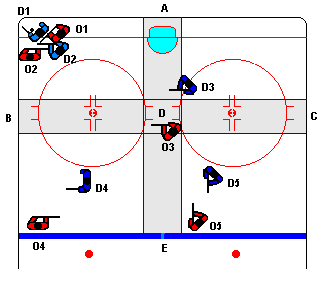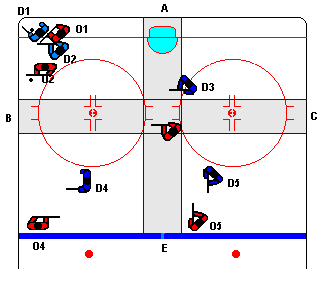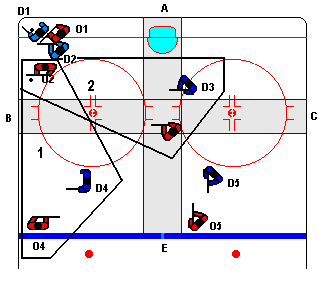
Rating Game Intelligence

Another developmental neglect for players in the area of "game intelligence". Again, many different philosophies arise when asking players and even coaches about what this comment would mean to them personally. I like to think that there are eight basic "game intelligences" or "game IQs" and one esoteric one. For example:
1 - Positional intelligence (defensive) knowing responsibilities within a specific zone and responsibilities of a specific position. Mostly descriptive of defensive one on one play and/ or tactical systems both near and away from the puck.
2 - Positional intelligence (offensive) knowing how to support the play and / or puck carrier either proximal or distal.
3 - Anticipation - reading off of the play and reacting correctly to possible options either defensively or offensively.
4 - Skill intelligence - playing to within one's level or competence. Using one's skill to maximum potential.
5 - Creative intelligence - Able to produce options aside from the norm extending one's specific skill abilities and producing a new twist reactively in a new situation.
6 - Intrinsic intelligence - extending one's level of play to maximize the intrinsic components that exist within the game itself such as - maxing zones, pushing game guidelines (pushing player offside for example to get call), taking advantage of referee or linesmen weakness either positionally or interpretationaly. Using the game environment to one's advantage (boards, lighting, nets, etc)
7 - Tactical intelligence - understanding options strategically either from a one on one, two on one, or one on two tactical environment (odd or even strength situations either defensively or offensively).
8 - Emotional intelligence - Knowing one's emotional strengths and weaknesses that may effect game performance positively or negatively.
**9 - Cognitive intelligence - ones visual comprehension and brain speed.
1 - Positional Intelligence (defensive).
There are two basic game strategies that players need to understand. "Zone" play and "man-on-man". Zone play is where a player is given a specific area of responsibility. Opposition players that come into this particular zone become that player's responsibility. One of the main problems with this type of defensive play is where areas of responsibility overlap as shown in the diagram below. The areas of Grey demonstrate these specific "Zones" (location may vary relative to quality of players and/or level played). In diagram No. 1 the players in Blue are defensive (obviously) and the player's in RED offensive (sorry to state the obvious).
Where problems occur is when one Offensive player (say O2 in this situation) comes up with the puck and heads to open ice. as shown in diagram No. 2.
Diagram No. 1 Diagram No. 2


I know that the answer here is obvious; "the near side winger drops down and takes him" As I had previously mentioned that hockey is based on two main principles, those that are even strength or multiples of one on ones, or odd man situations either to advantage or disadvantage. We have in the above situation (diagram No. 2) several 2 on 1 options available to the puck carrier depending on the lane chosen to the net as well as how fast D2 recovers.
Diagram No. 3

Areas of responsibility become vague when this type of situation occurs. Certain rules apply depending on where O2 decides to go. These rules govern lanes of priority. Basically, if we are going to concede that this player is in a position to create an offensive opportunity, then we must give him the one that provides the least chance of scoring a goal. In the above situation, D5 may drop down to cover offensive player in the slot, while D3 plays the puck carrier one on one. What is interesting is that some of you reading this will probably disagree, thinking that D4 should drop down instead giving up the point option pass. Again, correct decision comes from lane chosen by defensive player, etc. but as we can see, in this particular instance, a defensive player as well as the players supporting the puck carrier must understand all possible options (skill of puck carrier, scoring ability, passing ability, other offensive supporting players, strengths/weaknesses or Goal-tender) in a split second and make the correct choice.
Comprehending all possibilities from all angles becomes quite a task for the coach since repetitive tactical simulations must be performed consistently so as to familiarize all players involved in the decision making process. This situation is only one variable. We have seen Gretzgy take the puck (from a similar 2 on 2 situation) behind the net (Zone A) and create havoc with defending players. How many goals did he set up form behind the net?
This kind of positional intelligence, of which there are many, many situations to analyze, is an important consideration when assessing a player's abilities.
2 - Positional Intelligence (offensive).
taking a look at the same situation from the offensive players point of view, we can see that several choices have to made that stem off of his choice of attack lane to the net as well as the reaction time and possible intervention of the D2 player out of the corner. Attacking the net with speed directly (in most cases) is the best option. This forces the defensive unit to make hasty decisions. He has two 2 on 1 options to consider depending on who moves to intercept. Again, CHOICES. In this case we are looking for Offensive intelligence. Quality of decision; attack lane, speed, use of supporting players, etc.


3 - Anticipation
This form of intelligence can be be described as having the ability to read subtle variations in player movement and/or being able to read probable outcomes in selective plays (knowing probable outcome of puck movement when shot on net either from a shooters habit, Goal-tenders react, or location of shot from and on the net). allowing one to think ahead of the playAnticipation is a critical component in the above depicted play. In the above situation O2 anticipated a weakness in the Defensive player D1 pinning the puck, and capitalized on the weak positioning and/or reaction time of D2. D2 anticipated poorly and left O2 in control of the puck. Anticipation, or better, the understanding and / or interpretation of supporting and opposition players body language and movement is absolutely the most important aspect of the transition game. Moving from offense to defense, defense to offense, defensive support or offensive support relies heavily on this form of game intelligence.
4 - Skill intelligence
Skill intelligence can best be described as playing to within one's level of SKILL competence. Using one's skill to maximum potential. As I have explained in the "Event Progression Analysis" and "Thought Process" page, one has to exhibit micro as well as macro skill intelligence. Most often we as coaches focus on the Macro level - performance and execution within a specific environment such as two on ones for example. A players decision making process is directly related to both their confidence level and well as their subconscious ability to pull a particular skill out their hat so to speak, and execute the proper option. If a player is not confident in a particular skill, under extreme conditions, that particular skill will not be utilized. I could go into great depth here about this "micro-macro" cycle and if you link into this page above, some of it will be explained. I will however, pose several questions for thought.
1 - How long does a player need to practice a particular skill before he begins to use it effectively?
2 - Do we take into consideration this developmental time block when running team and/or individual skill practices?
3 - How much impact does a coach have on a player's ability to learn - either through praise or criticism?
4 - How much impact does a coach have on a player's confidence?
4 - What is the impact of a player losing confidence have on his ability to integrate new skills into game play?
5 - Once extremely criticized, how long does it take a player to recover move back into the learning cycle?
There are several points that we must consider:
1 - Player's will make mistakes - it is part of the learning process. No one is perfect all the time. WE must understand this and teach that mistakes are an acceptable part of a player's development however, repetitive SAME mistakes are not (depending on the length of time between them). I have often said to players; "I don't care if you make a mistake, just make a new one". I never criticize a new mistake. I encourage a player to learn from it. I am a teacher and I understand my role is to provide alternate options as well as give players a chance to recreate the previous situation that created the mistake in the first place so that the correct option can be explained again, demonstrated, and corrected.
2 - We must encourage the learning process; "try something new"- when the opportunity applies. A league final game tied in overtime may not be the best time to experiment.
3 - We must give players this opportunity as often as possible and encourage successfully learned applications. Exhibition games, controlled scrimmage practices, blow out games either for or against.
4 - We must make players understand when to experiment and when to follow the "tried and proven" method. Players like "NEW" but discipline is also a necessary trait.
A player's skill intelligence can be judged several ways.
1 - Circumstance or event that took place and what skill or skills were chosen either to counter or support?
2 - Quality of skill and effect on the event.
3 - Player's personal assessment process - happy or unhappy with decision.
4 - Ability to adapt if primary decision was bad - new skill utilized etc.
5 - Creative intelligence
Can best be described as a player's ability to produce options aside from the norm; extending one's specific skill abilities and producing a new twist reactively in a new situation. WOW. What a mouth full. Over the many years that I have coached, I have seen very few true creative events. When they have occurred, the two most common answers that I have received is; "I don't know where that came from"......or ..."you know, I have been thinking about trying that for a while and I guess it just happened".
I was fortunate enough when I was very young, to spend many hours inside an ice rink. Working as an ice man, I have been involved in a complete arena rebuilt and design where I could partake in the actual corner design and manufacture, board height, gate size, etc. All of this adds to the creative process. Being around the game environment many, many hours had led me to try new things. For example, how often have we seen some weird bounce of the puck result in some outrageous scoring opportunity. Working around an ice rink for the past 30 years, I have had the opportunity to try an duplicate these strange events and have found that some of them can be repeated both predictably and effectively. We have seen Gretzgy do a couple of amazing things over the years, but what is important to understand is that somewhere along the way, HE HAD TO ACTUALLY THINK ABOUT IT. True creative genius, as I have interpreted it, is the ability to take all possible factors into consideration, and using ever available resource at one's disposal, come up with a new twist on an old situation under extreme conditions.
6 - Intrinsic intelligence
Can best be described as extending one's level of play to maximize the intrinsic components that exist within the game itself such as - maxing zones, pushing game guidelines (pushing player offside for example to get call), taking advantage of referee or linesmen weakness either positionally or interpretationaly. Using the game environment to one's advantage (boards, lighting, nets, etc).
Intrinsic intelligence can often be mistaken for creative intelligence. A smart player will ALWAYS attempt to push an opposition player offside, or skate to maximize zones either with or with the puck, offensively or defensively. Players that are called "cheap" have a pretty amazing comprehensive ability of a referee's strengths and weaknesses. They know when to pull payers feet out, butt end, spear, intimidate, etc. They certainly push the boundaries of fair play. The WHL and NHL have gone so far as to provide a two ref system because of this fact. Today, there is so much going on inside and away from the play that it has become almost impossible and even undesirable to call everything. Players have become more Intrinsically intelligent, albeit in ways that best benefit themselves fairly or unfairly.
Most Intrinsic intelligence is focal primary through role specificity. A Goal Scorer will utilize certain game attributes differently than a checking player. Each player can best be identified first through role and then through type of decision.
7 - Tactical intelligence
Tactical intelligence can best be identified by a player's play options selections strategically either from either even or uneven strength situations either defensively or offensively. While these situations can be categorized under Macro skill set environments, the actual decision making process can be separated and exist independently. The decision to pass the puck or carry it is different that actually doing so. We are not looking at the quality of pass or carry, however, just at the decision to either do or not do. I know many players who make correct passing choices yet their saucer pass execution is horrible.
This form of Game Intelligence is the most often criticized part of a player's game. Everyone in the world is a hockey expert. How many times have you heard; "he should have passed"..."he should have shot"..."he should have taken the man". Take any game played on TV and hard core fans battle it out tactical el tactical afterwards, in their own way. It is easy to say what a player should have done but we must understand first of all, what was he thinking when he chose THAT particular option. I have heard some surprising answers when I have questioned my players regarding their choice. I have found most of the time that if what they thought they saw was actually the way it was, their play choice was very good. What apparently was the problem was not their decision making process, it was their observation skills. I have found this was the main contributing factor to the quality of a player's decision making process. Again, we criticize players by; "he skates with his head down". or even worse "the kid is just plain stupid". How about an all-time favorite; "million dollar hands but a ten cent brain" or "the kid's got great tools, just no tool-box".
Visual acuity is one of the most important components of tactical success. Seeing ALL the information allows a player to make an intelligent decision. A mistake is made when one detail is over- looked.
8 - Emotional intelligence
Can best be described as knowing one's emotional strengths and weaknesses that may effect game performance positively or negatively. How many times have we seen a player retaliate. Too many to mention right. About the ability to play through pain or fatigue. Mental toughness falls into this category. How about a player's ability to react to criticism or even to fan worship. Arrogance falls into this category. This form of intelligence is pretty easy to identify, especially after we get to know a player.
**9 - Cognitive intelligence
Can best be described as a player's ability to visually process information quickly and effectively. I will leave you to ponder this more.
To continue with the above principles, we can categorize and/or simplify them under the following headings.
1 - Time management
2 - Space management
3 - Skill management
4 - Shot management
1 - TIME MANAGEMENT - Time management is a term used to describe a player or player's ability to effectively use the time between event variables; primary, proximal or distal to his/ her advantage. Player's can create or lose time depending on how they move, look/see, anticipate, skill select, etc. An example would be a player that skates hard into position away from the puck to create more time to read off the play and/or select secondary option. This could be on a breakout where to opposition has put the puck in deep on a line change and the secondary receiver skates hard into a support position so that when the puck carrier has full control the reception can be made decisively (since all variables have been seen and taken into consideration) and a higher percentage secondary option selected. A player hesitating on a line change so as to take advantage of the puck and opposition player position to create an advantage (coming out of the penalty box for example).
2 - SPACE MANAGEMENT - Space management is a term used to describe several different variables where zone or man on man. How a player stretches the play, controls his check man on man or takes care of his particular zone would be examples. The term "Gap control" would fall under this category.
3 - SKILL MANAGEMENT - Skill management is a term that would be describe how a player uses his skills within a time variable (shift, period, or over-all game) or a space variable (man on man, zone, etc). An example would be how a player uses his speed. Deceptive skating would be an example; why waste the energy on the best defenseman, hide it and use it against the worst defenseman. When, how and where a particular skill would be used would also fall into this category.
4 - SHOT MANAGEMENT - Shot management is a term that describes how, when, where (on ice), where (on net) and why a player chooses a particular shot. For example: a low shot to the far side when late in a line shift with the opposition fresh would not be a good idea due to the fact that the rebound or missed shot would rim and possibly create a odd man rush against.. A high shot to the upper body and head of a goal tender to keep him off balance would be specific to location as would shooting to the pads to create rebounds when angles are covered would be another example. of shot management. Using a wrist shot from the point as opposed to a slap shot when opposition forwards pressure hard is another example.
Copyright © 1996 by Ron Johnson. All rights reserved.